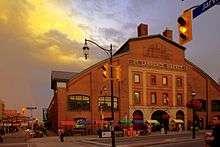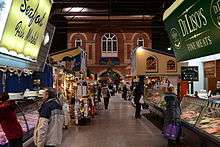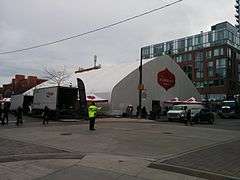St. Lawrence Market



St. Lawrence Market is a major public market in Toronto, Ontario, Canada. It is located at Front St. East and Jarvis St in the Old Town district of Toronto. There are three buildings in the complex, each having a different purpose. St. Lawrence Market North, on the north side of Front St, hosts weekly farmer's markets and antique markets. A public market has been held on the north building site since 1803. Several buildings have housed the building, the most recent built in 1968. St. Lawrence Market South, on the south side of Front St, is open daily, hosting food stalls, restaurants and the St. Lawrence Market Gallery. The South building dates to 1845, and has been rebuilt twice, and still incorporates a section of its original building which was used as Toronto City Hall from 1845. St. Lawrence Hall is an event and office building on King at Jarvis, built in 1850.
St. Lawrence Market was named the world's best food market by National Geographic in April 2012.[1][2] Starting in 2015, the North building has shut to allow for redevelopment. While the North site is redeveloped, its market functions have moved to south of the South building in a temporary building.
History
By 1803 the population in York, Upper Canada had increased to the point where a public market was needed. Upper Canada Lt. Governor Peter Hunter established a weekly market day and designated an area. His proclamation appeared in the November 3, 1803 issue of The Upper Canada Gazette saying, “Whereas great prejudice hath arisen to the inhabitants of the town and township of York and of other adjoining townships from no place or day having been set apart for exposing publicly for sale, cattle, sheep, poultry and other provisions, goods and merchandise brought by merchants, farmers and others for the necessary supply of the town of York and whereas great benefit and advantage might be derived to the inhabitants and others by establishing a weekly market at a place and on a day certain for the purpose aforesaid;”[3]
The original market was known as Market Square and people gathered there on Saturdays at the corner of King Street and New Street, (today's Jarvis St) stretching west to Church Street and south to Palace (today's Front St), with a creek running through the center from King south to the bay.[4] The market square was the center of the city's social life where auctions took place and public punishments were carried out.[3] In the earliest days of the town, when slavery was still legal, this included auctions of black slaves.[5] Town bylaws prohibited the selling of butter, eggs, fish, meat, poultry, and vegetables between the hours of 6am and 4pm on Saturdays, except at the market.[5]
The first market building, a temporary shelter, 24 feet (7.3 m) by 36 feet (11 m) was built in 1814.[5] The first permanent structure was built in 1820. In 1823, the town's first public well was dug on the property.[5] In 1831, the wooden market building was torn down and a quadrangular brick building with arched entrances at the sides was built. The building's office space served as temporary home to City Council until 1845.[6] This building was used until the 1849 Toronto Great Fire destroyed the northern side of the building and it was torn down.
After the fire, St. Lawrence Hall was built, along with a new market building between it and Front. The market building was replaced in 1904 and 1968. The present St. Lawrence Market South building was built in 1845 as Toronto City Hall and was rebuilt in 1850[7] and 1904 and renovated in 1972. A canopy was built between the north and south buildings and this was torn down in the 1950s.
In the nineteenth century, Toronto had three public markets named after the wards within which they were located. St. Lawrence Market, founded in 1803, was the first, St. Patrick's Market at 238 Queen Street West was the second, created in 1836, and still exists in the form of an organic food court within its current building, constructed in 1912,[8] and St. Andrew's Market on the block between Richmond, Adelaide, Brant and Maud streets was built in 1850 and is now a park.[9]
The City of Toronto is now proceeding with another market building on the site of the North building. A new four-storey building with atrium is to replace the 1968 North building. The farmer's market has relocated to 125 The Esplanade, just south of the South building. Foundations of the 1831, 1851 and 1904 North Market buildings were found below the floor of the 1968 building.[10]
| Wikimedia Commons has media related to St. Lawrence Market. |
 View of first building (1820–1831) to enclose farmer's market at King and Jarvis
View of first building (1820–1831) to enclose farmer's market at King and Jarvis.jpg) 1831 building at King and Jarvis
1831 building at King and Jarvis Canopy connecting south and north buildings in 1952.
Canopy connecting south and north buildings in 1952. Looking north on Jarvis in 1907.
Looking north on Jarvis in 1907..jpg) St. Lawrence Market North (to be demolished)
St. Lawrence Market North (to be demolished)
See also
References
- Hounsom, Eric Wilfrid (1970). Toronto in 1810. Toronto, Ontario: Ryerson Press. ISBN 0770003117.
- Notes
- ↑ "St. Lawrence Market in Toronto named world's best food market by National Geographic". Yahoo! News. April 5, 2012.
- ↑ Goldberg, Lina (February 24, 2013). "10 of the world's best fresh markets". CNN Travel. Retrieved February 24, 2013.
- 1 2 Peppiatt, Liam. "Chapter 29: The Public Markets". Robertson's Landmarks of Toronto Revisited.
- ↑ Hounsom 1970, p. 168.
- 1 2 3 4 Hounsom 1970, p. 169.
- ↑ http://www.lostrivers.ca/content/points/southmarket.html
- ↑ Peppiatt, Liam. "Chapter 29: The Public Markets". Robertson's Landmarks of Toronto Revisited.
- ↑ http://app.toronto.ca/HeritagePreservation/details.do?folderRsn=2438919&propertyRsn=214346
- ↑ http://tayloronhistory.com/2011/07/10/torontos-farmers-markets/
- ↑ Mitanis, Marcus (September 17, 2015). "Touring the Archaeological Finds at St. Lawrence Market North". UrbanToronto. Retrieved November 11, 2015.
External links
- A History of the St. Lawrence Market and the Market Square that Preceded it
- St. Lawrence Market
- Photo Essay from St. Lawrence Market